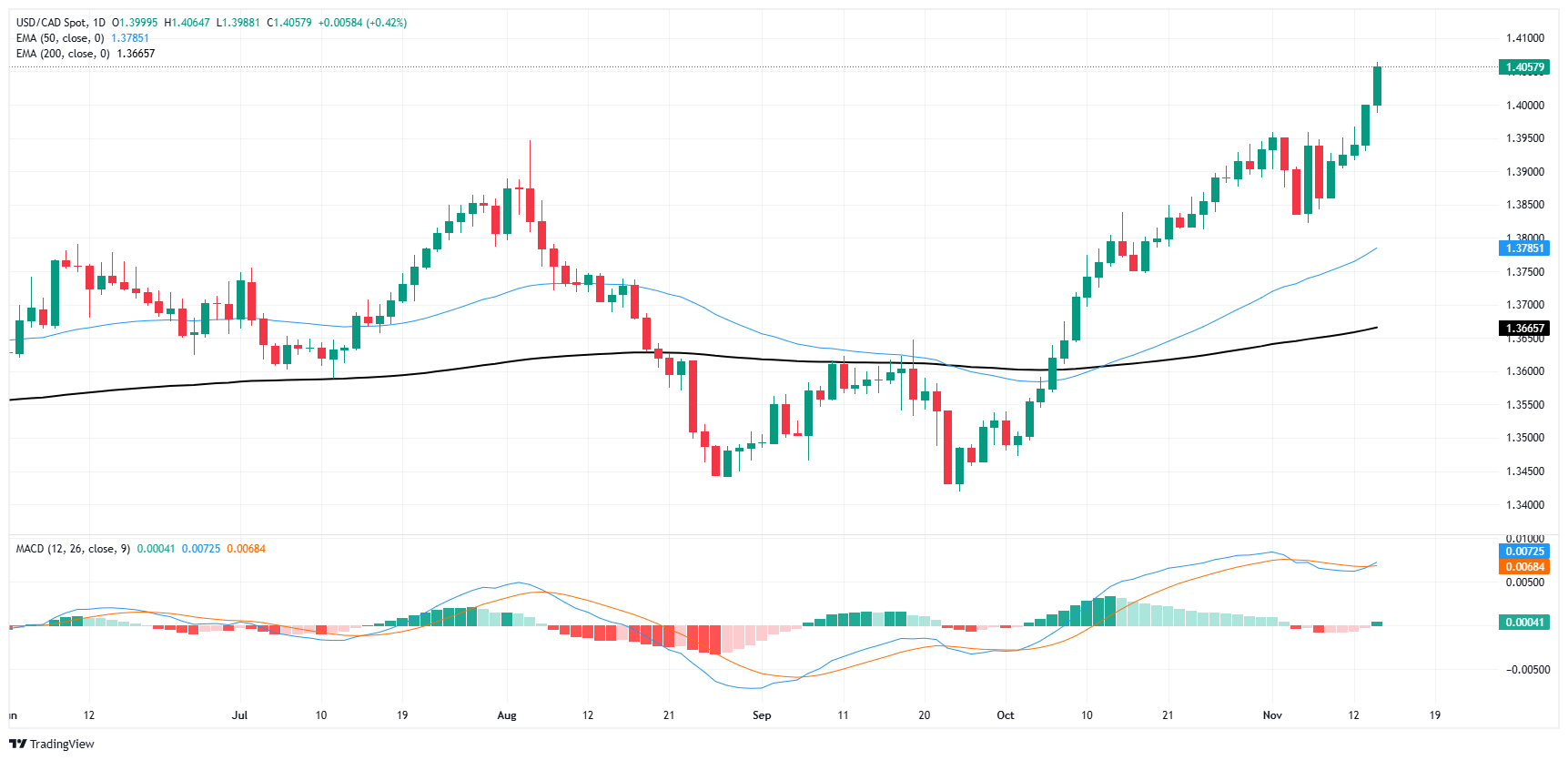Canadian Dollar sinks to multi-year lows on data-light Thursday
- The Canadian Dollar found new lows against the Greenback on Thursday.
- Canada remains largely absent from the economic calendar until next week.
- US PPI inflation accelerated faster than expected for the year ended October.
The Canadian Dollar (CAD) backslid into new lows against the Greenback on Thursday, slipping to a fresh 54-month low and sending the USD/CAD pair to its highest prices in four and a half years. The pair broke through the 1.4000 handle, with the US Dollar getting sent even higher on the back of a slight upswing in US Producer Price Index (PPI) inflation figures on Thursday, sending the Loonie to multi-year lows.
Canada remains absent from the economic calendar this week with a notable lack of meaningful data releases on the radar. CAD traders will be forced to sit on their hands until next Tuesday’s Canadian Consumer Price Index (CPI) inflation update for October, which is unlikely to deliver much good news to Loonie fans.
Daily digest market movers: Canadian Dollar gets pummeled by US producer inflation
- The Canadian Dollar found a new four and a half year low against the Greenback on Thursday, tumbling to its lowest bids against the safe haven US Dollar in 54 months.
- US PPI inflation accelerated a little bit more than expected in October, keeping investors wary and reminding them that rock-bottom interest rates are much easier to wish for than to get.
- US core PPI inflation for the year ended in October rose 3.1% YoY, more than the forecast 3.0% and rising even further from the previous period’s revised 2.9%, which initially printed at 2.8%.
- Canadian CPI inflation data due next week is unlikely to deliver much good news to Loonie bulls as inflation in Canada slumps and the Bank of Canada (BoC) gets pulled into a rate cutting spiral.
- US Retail Sales figures due on Friday could give the US Dollar one last kick up the charts to wrap up the trading week.
Canadian Dollar price forecast
With USD/CAD breaching into multi-year highs, a chasm is opening up below the Canadian Dollar (CAD). After a brief reprieve last week, the Greenback is once again on pace to close higher against the CAD on a weekly basis. USD/CAD has risen nearly 5% since finding a floor near 1.3400 in September, cracking through long-term technical resistance and piercing the 1.4000 handle.
USD/CAD daily chart
Canadian Dollar FAQs
The key factors driving the Canadian Dollar (CAD) are the level of interest rates set by the Bank of Canada (BoC), the price of Oil, Canada’s largest export, the health of its economy, inflation and the Trade Balance, which is the difference between the value of Canada’s exports versus its imports. Other factors include market sentiment – whether investors are taking on more risky assets (risk-on) or seeking safe-havens (risk-off) – with risk-on being CAD-positive. As its largest trading partner, the health of the US economy is also a key factor influencing the Canadian Dollar.
The Bank of Canada (BoC) has a significant influence on the Canadian Dollar by setting the level of interest rates that banks can lend to one another. This influences the level of interest rates for everyone. The main goal of the BoC is to maintain inflation at 1-3% by adjusting interest rates up or down. Relatively higher interest rates tend to be positive for the CAD. The Bank of Canada can also use quantitative easing and tightening to influence credit conditions, with the former CAD-negative and the latter CAD-positive.
The price of Oil is a key factor impacting the value of the Canadian Dollar. Petroleum is Canada’s biggest export, so Oil price tends to have an immediate impact on the CAD value. Generally, if Oil price rises CAD also goes up, as aggregate demand for the currency increases. The opposite is the case if the price of Oil falls. Higher Oil prices also tend to result in a greater likelihood of a positive Trade Balance, which is also supportive of the CAD.
While inflation had always traditionally been thought of as a negative factor for a currency since it lowers the value of money, the opposite has actually been the case in modern times with the relaxation of cross-border capital controls. Higher inflation tends to lead central banks to put up interest rates which attracts more capital inflows from global investors seeking a lucrative place to keep their money. This increases demand for the local currency, which in Canada’s case is the Canadian Dollar.
Macroeconomic data releases gauge the health of the economy and can have an impact on the Canadian Dollar. Indicators such as GDP, Manufacturing and Services PMIs, employment, and consumer sentiment surveys can all influence the direction of the CAD. A strong economy is good for the Canadian Dollar. Not only does it attract more foreign investment but it may encourage the Bank of Canada to put up interest rates, leading to a stronger currency. If economic data is weak, however, the CAD is likely to fall.

